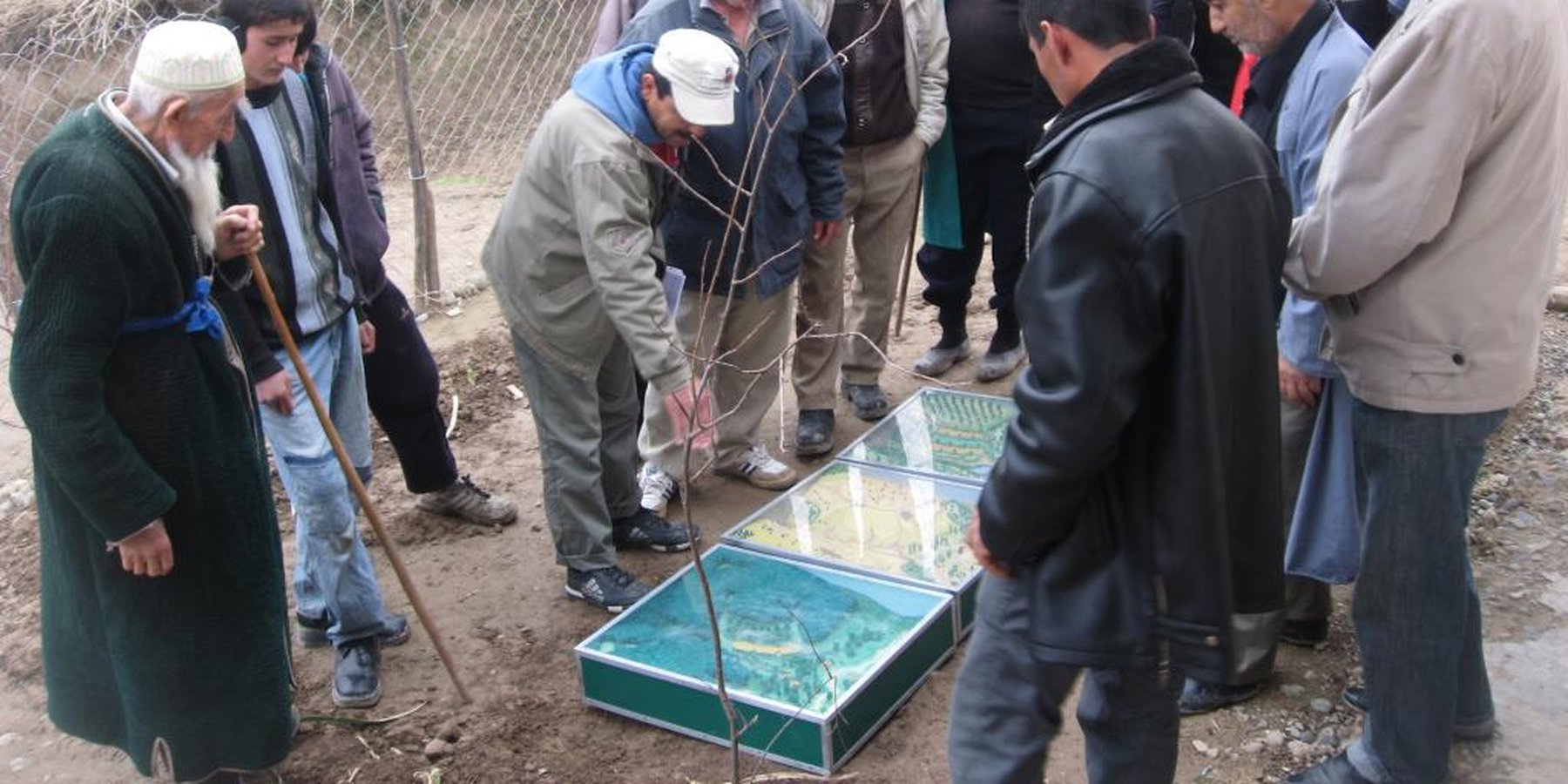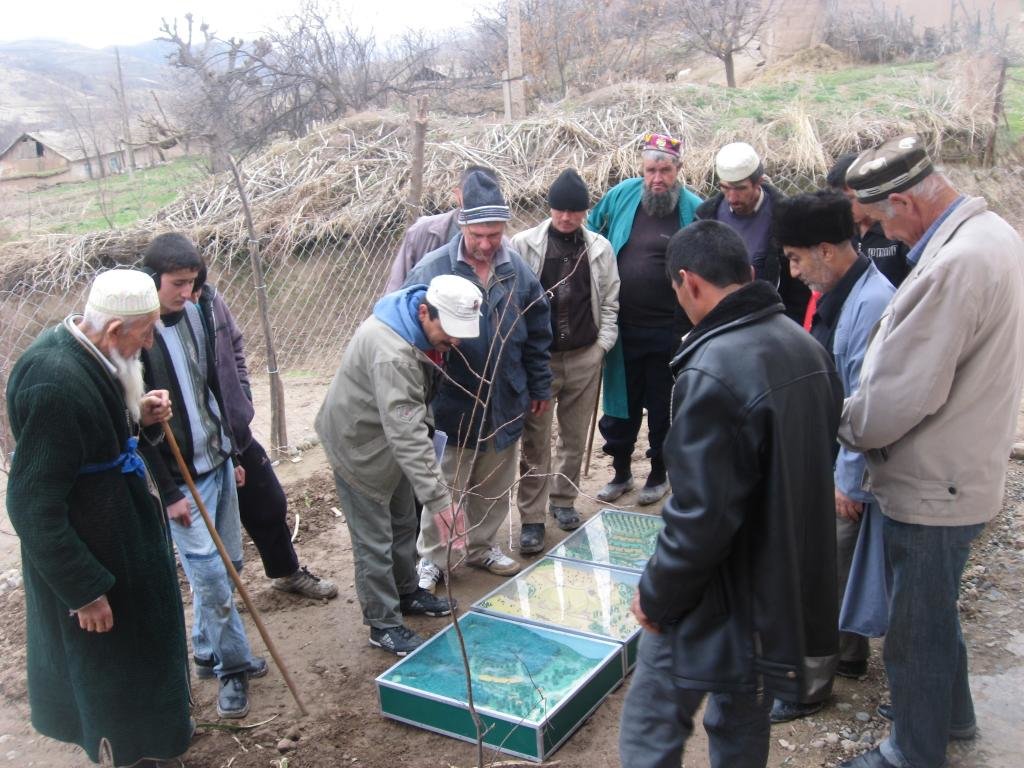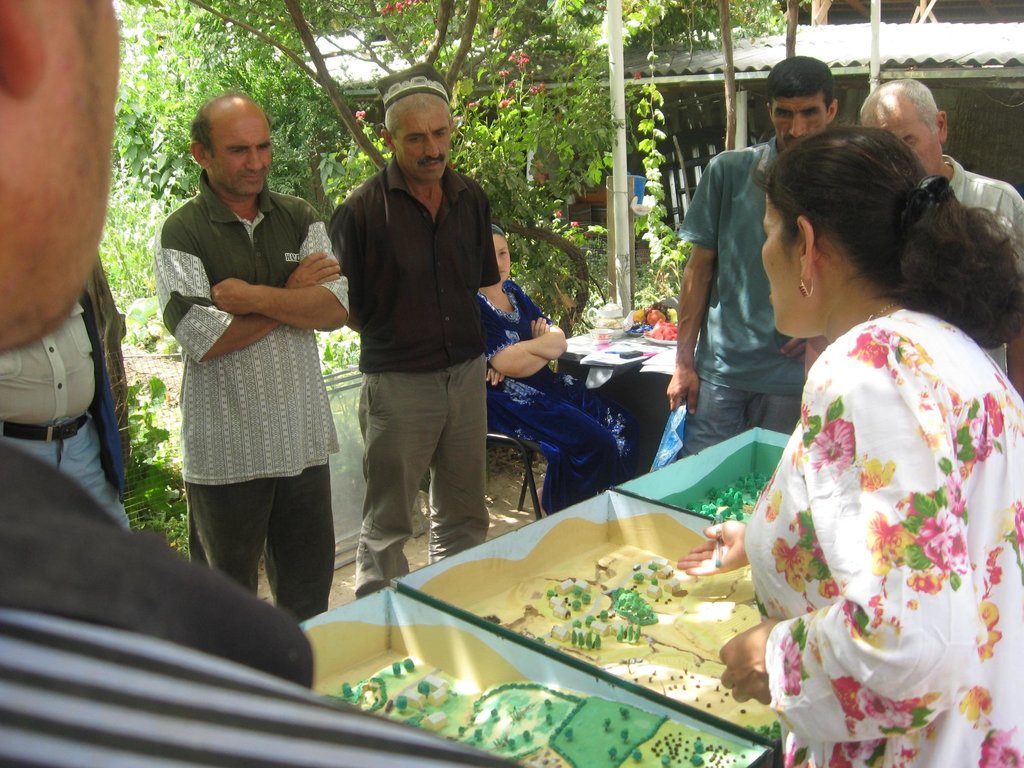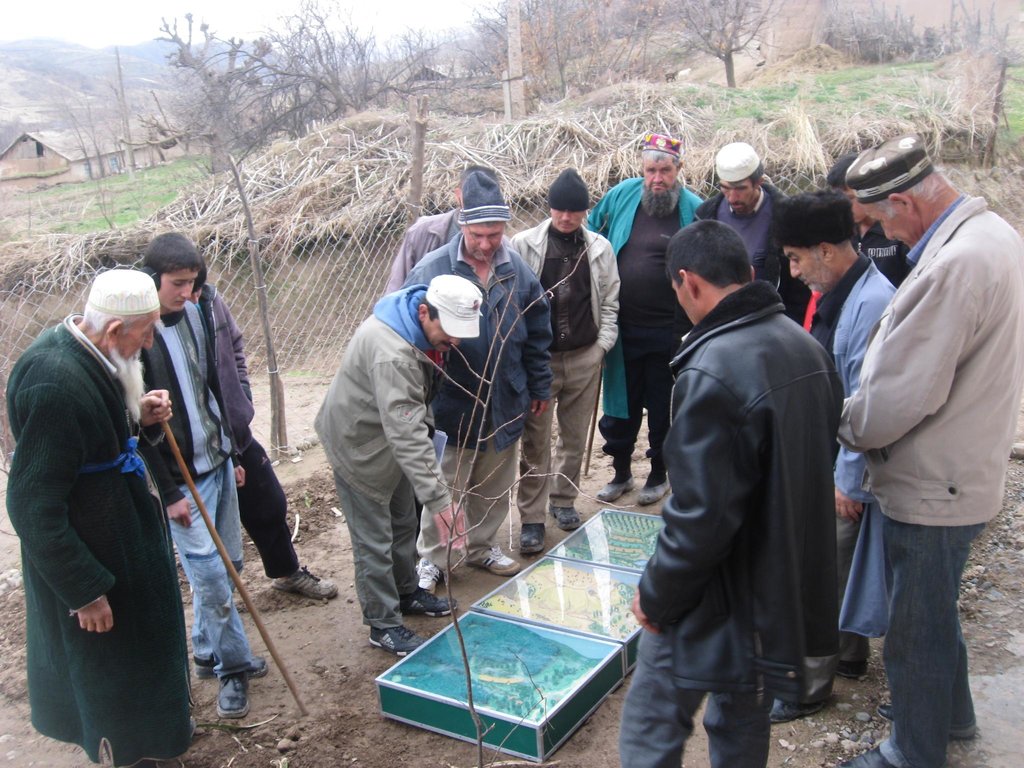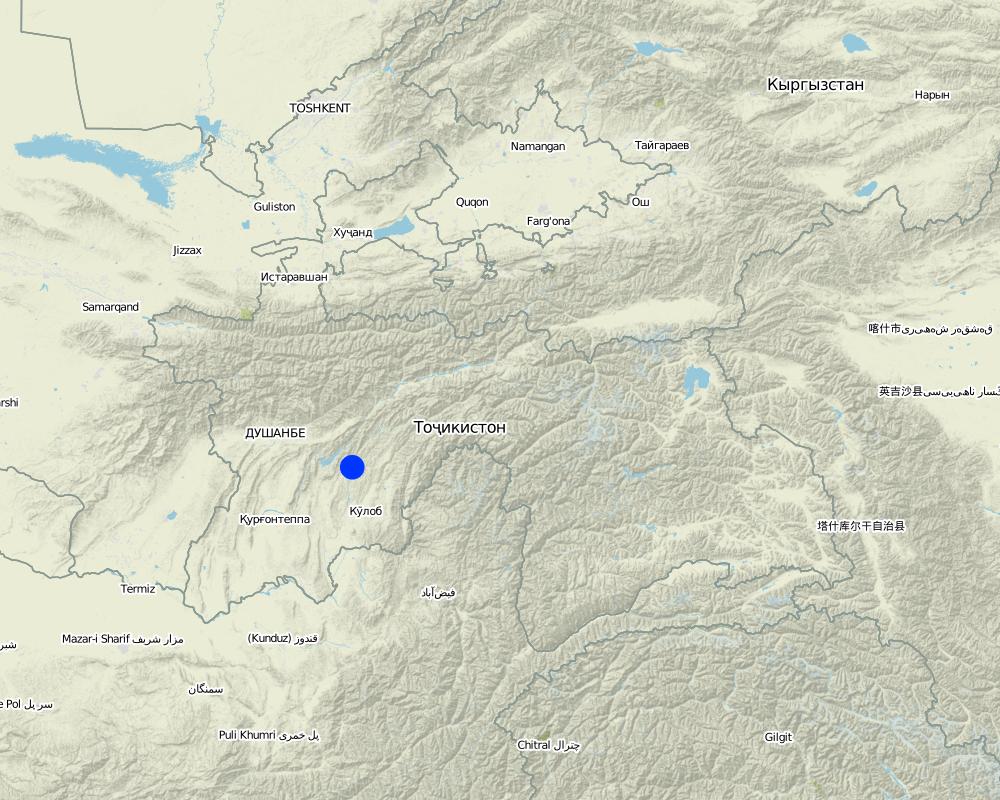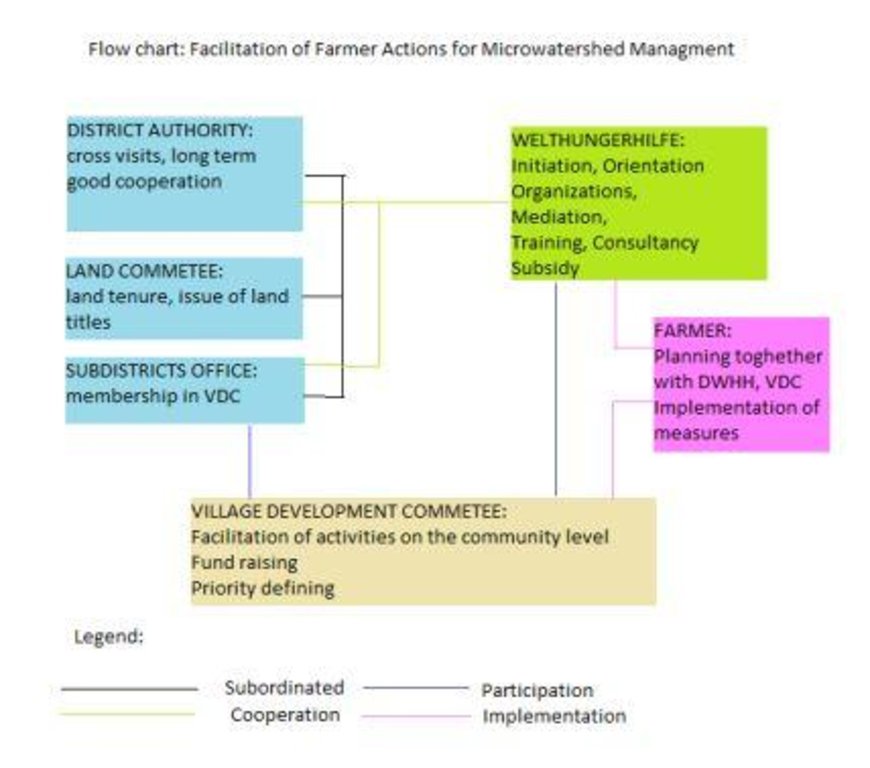Facilitation of micro-watershed management for farmers [Тажикистан]
- Шинийг нээх:
- Шинэчлэх:
- Мэдээлэл цуглуулсан: Manuchehr Rakhmatdzhonov
- Редактор: –
- Хянагчид: David Streiff, Alexandra Gavilano
Фасилитасияи амалиётхои дехкон барои идораи микрохавза
approaches_2443 - Тажикистан
Бүлгүүдийг үзэх
Бүгдийг харуулах Бүгдийг хаах1. Ерөнхий мэдээлэл
1.2 Арга барилыг баримтжуулах болон үнэлгээ хийхэд оролцсон хүн эсвэл байгууллагын холбоо барих хаяг
ГТМ мэргэжилтэн :
ГТМ мэргэжилтэн :
ГТМ мэргэжилтэн :
Bronkal Daniel
daniel.bronkal@welthungerhilfe.de
Герман
Арга барилыг баримтжуулах/үнэлэх ажилд дэмжлэг үзүүлсэн байгууллага(ууд)-ын нэр (шаардлагатай бол)
Deutsche Welthungerhilfe - Тажикистан1.3 WOCAT-аар баримтжуулсан өгөгдлийг ашиглахтай холбоотой нөхцөл
Эмхэтгэгч болон гол мэдээлэгч хүн(хүмүүс) WOCAT аргачлалаар баримтжуулсан мэдээллийг ашиглахтай холбоотой нөхцлийг хүлээн зөвшөөрсөн.
Тийм
1.4 ГТМ-ийн технологийн асуулгын(д) суурь мэдээлэл(д)
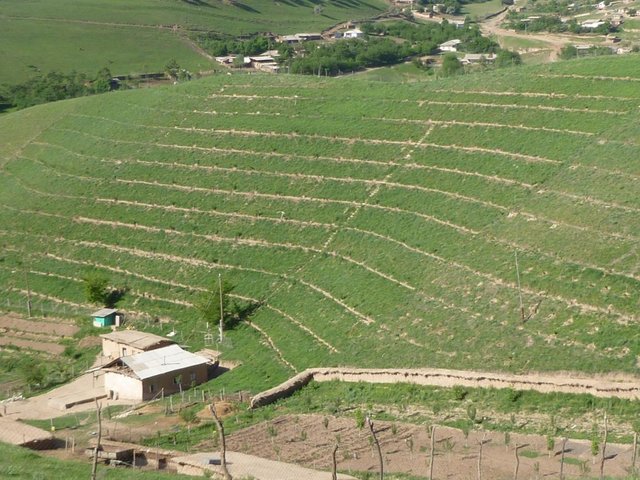
Gradual development of bench terraces from contour ditches [Тажикистан]
Use of the SLM technology facilitates the development of bench terraces from contour channels by gradually removing soil material up the slope for an estimated 5 years until the terraces on the slope reach a desired width of 1.2 m.
- Мэдээлэл цуглуулсан: Manuchehr Rakhmatdzhonov
2. ГТМ Арга барилын тодорхойлолт
2.1 Арга барилын товч тодорхойлолт
Relying on integrated watershed management principles, farmers were assisted by the project to implement soil and water conservation measures in a microwatershed.
2.2 Арга барилын дэлгэрэнгүй тодорхойлолт
Арга барилын дэлгэрэнгүй тодорхойлолт :
Aims / objectives: To strengthen the capacity of the community to plan and implement integrated natural resource management approaches, at micro watershed level in sustainable ways. These include; conserving soil by introducing actions to rehabilitate the eroded land, stop gully formation resulting from water run-off; enable water retention to secure soil moisture for a longer time period; mitigate effects of overstocking resulting in overgrazing; hoof erosion and soil compaction; reverse inappropriate agriculture practices towards more efficient and environmentally friendly management types; enable better employment and higher income generation to improve the livelihood standards and food security.
Methods: The project facilitated the following activities: Farmer participation, and using their initiative, community involvement in the planning, fundraising and implementation. Farmers increased their own contribution for material inputs, and a greater than 50% rate of adoption of the innovation was seen. The project also funded 'on the job' training, technical support, consultancy, and mediation of communication between parties.
Stages of implementation: 1. Awareness raising, 2. On the job training, 3. Watershed management activity planning, 4. Implementation, 5. Monitoring, 6. Evaluation, 7. Readjustment based on results, 8. Further replication in new area
Role of stakeholders: The DWHH Project had a leading role in initiation, orientation, awareness raising, mobilisation, training, consultancy, input provision and mediation of communication to land committee. Farmers have been actively participating, have provided labour input / financial contribution, provided indigenous knowledge and skills. Local authorities - providing land titles, participation in planning and decision making process Village Development Committee (VDC) - community mobilisation, information dissemination, input / finance documentation, fund raising.
Other important information: There are 5 households in the microwatershed. Almost 40 people live in all HH, all are Tajiks. Members of all households took part in discussion rounds and training. Non of HHs were strong enough to implement measures on own funds. One HH has rejected implementation of measures, due lack of capacity and lack of trust of the project's success. Women: farmers came to the discussions together with their wives, women took part in training, in implementing almost all of the adoption measures, and equally benefited from the project. However, they were not involved in decision making.
2.3 Арга барилын зурагууд
2.5 Арга барил нэвтрүүлсэн улс орон / бүс нутаг / байршил
Улс :
Тажикистан
Улс/аймаг/сум:
Tajikistan, Khatlon
Байршлын дэлгэрэнгүй тодорхойлолт:
Baljuvon / Khirob
Map
×2.6 Арга барилыг эхлэх, дуусах огноо
Эхлэх жилийг тэмдэглэ:
2009
Хугацаа дуусах жил (Хэрэв арга барил удаанаар ашиглаагүй бол):
2011
2.7 Арга барилын төрөл
- Сүүлийн үеийн орон нутгийн санаачлага / шинэчлэл
2.8 Арга барилын үндсэн зорилго, зорилтууд
The Approach focused mainly on SLM with other activities ( land use change, resource conservation, capacity building, focus on low cost local material, income generation, on the job training)
To assist farmers in the planning and implementation of activities for the conservation and improvement of the local land, to enable conditions for replication of the approach/technology, and to improve food production, and in the long run provide income generation.
The SLM Approach addressed the following problems: Lack of land tenure rights implementation. Nominal state farm reorganisation. Low agricultural production - lands depleted of nutrients, very low yields, no crop rotation, overgrazing. Soil degradation, progressing land mass transport, gully formation. Lack of technical knowledge and awareness of soil & water conservation measures. Lack of cash to invest in development of land - just limited capacity to invest but need external financial input. Conflict over land use - livestock owners are against land enclosures. Poverty - underlying cause of general lack of potential to invest in development.
2.9 Арга барилын хүрээнд хэрэгжсэн Технологи/Технологиудад дэмжсэн эсвэл саад учруулсан нөхцлүүд
санхүүгийн нөөц, үйлчилгээний хүртээмж / боломж
- Хазаарлалт
Technology implementation has required a major investment for imported materials, like a metal net for fencing or fuel. Most farmers could not afford themselves to buy costly inputs. Moreover such inputs were rarely available on the local market.
Treatment through the SLM Approach: The INGO covered the costs of 50% of each action, here mainly higher price inputs were paid off. The low-cost approach fits the financial capacity of the target group.
Бүтэц зохион байгуулалт
- Хазаарлалт
Capacities of communities and local authorities to jointly plan and implement SLM activities at micro-watershed level was weak.
Treatment through the SLM Approach: Knowledge improved on the complex interrelations in natural ecosystems (farmers and staff of local authorities). Project cooperation was not limited to those interested, there was inclusion of gov. structures (agriculture, land committee, ecology) committ
Хууль, эрхзүйн хүрээ (газар эзэмшил, газар, ус ашиглах эрх)
- Идэвхижүүлэх
The existing land ownership, land use rights / water rights moderately helped the approach implementation: On going legislative development in land tenure and farming provides good opportunities for implementation of the approach. But, ongoing nominal farm reorganisation and corruption at the local level, together with farmers reduced awareness of their land use rights requires more effort, time and funds in the application of SLM approaches. In this situation, DWHH has a good reputation in the district administration and with locals and so this helped overcome many barriers more easily.
- Хазаарлалт
Implementing the land tenure law and the privatisation of state farms is still a difficult process with many inconsistencies for people claiming a land title in the area.
Treatment through the SLM Approach: There are a few instances where the project was able to support farmers in getting land-titles to degraded land plots which they then had to rehabilitate using SLM technologies.
ГТМ-ийн талаарх мэдлэг, техникийн дэмжлэг авах боломж
- Хазаарлалт
Treatment through the SLM Approach:
3. Оролцогч талуудын оролцоо ба үүргүүд
3.1 Арга барилд оролцогч талууд болон тэдгээрийн үүргүүд
- Орон нутгийн газар ашиглагч / орон нутгийн иргэд
Village Development Committee, farmers
Men have played bigger role in the organisation of activities, in the implementation of more manual work, whereas, women took part in the lighter work and in routine maintenance.
Most of the participating households live below the poverty line.
Farmers joined under one microwatershed approach, male (wife assisted), middle age, Tajiks, rural middle class.
- ГТМ-ийн мэргэжилтэн/ хөдөө аж ахуйн зөвлөх
Project TAJ1068 staff, and an international consultant
- ТББ
Deutsche Welthungerhilfe
- Орон нутгийн захиргаа
Subdistrict, District Heads, Agriculture, Land committees, Forestry department
3.2 Арга барилын янз бүрийн үе шатанд орон нутгийн газар ашиглагчид / бүлэглэлүүдийг татан оролцуулах
| Орон нутгийн газар ашиглагч / орон нутгийн иргэдийн оролцоо | Хэн оролцсоныг тодорхойлж, үйл ажиллагааг тайлбарлана уу | |
|---|---|---|
| санаачлага/идэвхжүүлэлт | интерактив | farmers meeting through VDC, orientation explaining goals, objectives, advertising in the local news paper, information boards in 6 watersheds |
| Төлөвлөгөө | интерактив | on site planning with farmers |
| Хэрэгжилт | интерактив | training on the job, material input and labour provision, cross visits |
| Мониторинг/ үнэлгээ | интерактив | data input, open to monitoring, communication on ongoing activities, collaboration while monitoring and evaluation |
| Research | интерактив | collaboration in the test for Acacia seed germination on the plot |
3.3 Диаграм (хэрэв боломжтой бол)
Тодорхойлолт :
Flow chart depicts the major actors involved during implementation of the approach. The relationship between stakeholders and primary functions is described as well.
Зохиогч :
Manuchehr Rakhmatdzhonov (16, Firdavsi Street 734003, Dushanbe)
3.4 ГТМ-ийн технологи/технологиуд сонгох шийдвэр
Хэрэгжүүлэх Технологи/Технологиудын сонголтыг хийж шийдвэр гаргасан хүнийг тодорхойлно уу:
- голдуу ГТМ-ийн мэргэжилтнүүд, газар ашиглагчидтай зөвлөлдсөний үндсэн дээр
Тайлбар :
Decisions on the method of implementing the SLM Technology were made by mainly by SLM specialists with consultation of land users. Focused on principles of farmer participation, self motivation and self help.
4. Техникийн дэмжлэг, чадавхи бүрдүүлэх, мэдлэгийн менежмент
4.1 Чадавхи бэхжүүлэх/сургалт
Газар эзэмшигчид / бусад оролцогч талуудад сургалт явуулсан уу?
Тийм
Хэн сургалтанд хамрагдсан бэ:
- Газар ашиглагчид
- хээрийн ажилтан / зөвлөх
- local land and agriculture departments, village development committee
Хэрэв шаардлагатай бол хүйс, нас, яс үндэс, гэх мэт. нэмнэ үү:
Land users: 5 men, 5 women, 30 to 50 years old, all Tajiks, all families.
Сургалтын хэлбэр :
- Ажил дээр
- үзүүлэнгийн талбай
- Олон нийтийн уулзалт
Хамрагдсан сэвдүүд:
Use of the A-frame, watershed model, tree planting in contour ditches, intercropping
4.2 Зөвлөх үйлчилгээ
Газар ашиглагчдад зөвлөх үйлчилгээ авах боломжтой байдаг уу?
Тийм
Зөвлөх үйлчилгээ үзүүлсэн эсэхийг тогтоо:
- Газар ашиглагчийн талбай дээр
Тодорхойлолт / тайлбар:
A chain of meetings with international consultants from India and Nepal: Key elements: consultation on watershed concepts and watershed choice, capacity building in strategy design , draft development plan for watershed management
The consultants were : Yashvant Tkhakur, India; Jaganat Joschi, Nepal
Advisory service is inadequate to ensure the continuation of land conservation activities; the govenment branches need more development and organisation to become able to manage land conservation activities; an independent advisory service is not in place, the only potential still exists within the DWHH Project
4.3 Институцийг бэхжүүлэх (байгууллагын хөгжил)
Арга барилаар дамжуулан институц байгуулагдаж эсвэл бэхжсэн үү?
- Тийм, бага
Байгууллагууд бэхжиж, үүсэн бий болсон түвшин(үүд)-г тодорхойлно уу:
- Орон нутгийн
Дэмжлэгийн төрлийг ялга:
- чадавхи бэхжүүлэх / сургалт
Дэлгэрэнгүй мэдээллийг өгнө үү:
Village development committee (VDC), use of locally available resources, focus on low cost
4.4 Мониторинг ба үнэлгээ
Мониторинг болон үнэлгээ нь арга барилын хэсэг үү?
Тийм
Тайлбар:
area treated aspects were ad hoc monitored by land users through observations; indicators: space used for technology
economic / production aspects were regular monitored by project staff through measurements; indicators: fodder produced cent/ha, vegetables
socio-cultural aspects were ad hoc monitored by project staff through observations; indicators: labour availability, health status
technical aspects were ad hoc monitored by project staff through observations; indicators: tree planting
bio-physical aspects were ad hoc monitored by project staff through observations; indicators: soil degradation, gully formation
no. of land users involved aspects were ad hoc monitored by project staff through observations; indicators: monthly trends, how hardworking they were, gender
management of Approach aspects were ad hoc monitored by land users through observations; indicators: technology adaptation based on own experience
There were no changes in the Approach as a result of monitoring and evaluation: None
There were few changes in the Technology as a result of monitoring and evaluation: Change of the design - adjustment of the contour boundary based on experience on the plot; Adjusting of tree planting in contour ditches according to the topography
4.5 Судалгаа
Судалгаа арга барилын хэсэг нь байсан уу?
Тийм
Сэдвийг тодруулна уу:
- Технологи
Дэлгэрэнгүй мэдээллийг өгч, хэн судалгаа явуулсныг бичнэ үү:
Tests were completed on the germination of Acacia seeds in two different setups: on the demo plot of the project and on the farmers plot.
Research was carried out both on station and on-farm
5. Санхүүгийн болон гадаад материаллаг дэмжлэг
5.1 ГТМ-ийн Арга барилын бүрэлдэхүүн хэсгийн жилийн төсөв
Хэрэв жилийн төсөв тодорхойгүй бол хягаарыг тодруулна уу:
- 2,000-10,000
Тайлбар (жнь: санхүүжилтийн гол эх үүсвэр / гол хандивлагчид):
Approach costs were met by the following donors: international non-government (material input: tools, fencing, planting material, diesel. etc.): 50.0%; local community / land user(s) (the rest of material input, labour, time (mainly low cost inputs)): 50.0%; other
5.2 Газар ашиглагчдад санхүүгийн / материаллаг дэмжлэг үзүүлсэн
Технологи / технологийг хэрэгжүүлэхэд газар ашиглагчид санхүүгийн / материаллаг дэмжлэг авсан уу?
Тийм
Хэрэв тийм бол дэмжлэгийн төрөл(үүд), нөхцөл, болон нийлүүлэгч(чид) бичнэ үү:
50% of activities were subsidised by the DWHH Project TAJ1068
5.3 Тодорхой зардлыг даахад чиглэсэн дэмжлэгт (хөдөлмөрийн хүчийг оролцуулаад)
- Тоног төхөөрөмж
| Ямар хөрөнгө оруулалт татаасаар олгогдсоныг заана уу | Ямар талбайн хэмжээнд | Тэтгэмж, урамшууллыг тодорхойлно уу |
|---|---|---|
| Багажууд | хэсэгчлэн санхүүждэг | hand tools |
- Хөдөө аж ахуй
| Ямар хөрөнгө оруулалт татаасаар олгогдсоныг заана уу | Ямар талбайн хэмжээнд | Тэтгэмж, урамшууллыг тодорхойлно уу |
|---|---|---|
| Үр, үрсэлгээ | хэсэгчлэн санхүүждэг | |
| manure | хэсэгчлэн санхүүждэг | |
- Барилга байгууламж
| Ямар хөрөнгө оруулалт татаасаар олгогдсоныг заана уу | Ямар талбайн хэмжээнд | Тэтгэмж, урамшууллыг тодорхойлно уу |
|---|---|---|
| metal net | Бүрэн санхүүждэг | |
- Дэд бүтэц
| Ямар хөрөнгө оруулалт татаасаар олгогдсоныг заана уу | Ямар талбайн хэмжээнд | Тэтгэмж, урамшууллыг тодорхойлно уу |
|---|---|---|
| сургууль | хэсэгчлэн санхүүждэг | school, 2 rooms thermo insulated |
- Бусад
| Бусад (тодорхойлно уу) | Ямар талбайн хэмжээнд | Тэтгэмж, урамшууллыг тодорхойлно уу |
|---|---|---|
| Fuel, diesel, oil | хэсэгчлэн санхүүждэг | 1/4 of the need |
Хэрэв газар ашиглагчийн хөдөлмөрийн хүч чухал байсан бол энэ нь аль хэлбэр байсан:
- сайн дурын
Тайлбар:
Rennovation of the chool for the children was a strong and vital argument demanding considerable investment. This was competed with the implementation of the SLM technology, where farmers had to make a choice; either spend the available funds for the school or continue with the SLM. The project has provided partial financial and technology support to farmers which made it easy to overcome the school situation and concentrate again on SLM activities.
5.4 Кредит
Арга барилын хүрээнд ГТМ-ийн үйл ажиллагаанд зориулж зээлд хамрагдсан уу?
Үгүй
5.5 Бусад урамшуулал, хэрэгсэл
ГТМ-ийн технологийг хэрэгжилтийг дэмжихэд ашигласан бусад урамшуулал, хэрэгсэл байсан уу?
Тийм
Хэрэв тийм бол, тодруулна уу:
Village development committee (VDC), use of locally available resources, focus on low cost
6. Нөлөөллийн дүн шинжилгээ ба дүгнэлт
6.1 Арга барилын нөлөөллүүд
Арга барил нь ГТМ-ийн технологийг хэрэгжүүлж, хадгалахад газар ашиглагчдад тусласан уу?
- Үгүй
- Тийм, бага зэрэг
- Тийм, зарим
- Тийм, их
Most of the previous types of damage caused by water runoff were prevented. Trees grew in a landscape where they didn't before, due to long dry periods and high livestock pressure from grazing. There was a change in the farmer's attitudes, who prior to witnessing the technology were highly sceptical
Арга барил нь эмзэг бүлгийнхнийг нийгэм, эдийн засгийн хувьд чадавхижуулсан уу?
- Үгүй
- Тийм, бага зэрэг
- Тийм, зарим
- Тийм, их
Only four families out of five in the microwatershed were able to receive the opportunity to improve their socio-economic status in the long term as a result of the project.
Арга барил нь ГТМ-ийн технологийг хэрэгжүүлэхэд саад учруулсан газрын эзэмшил / ашиглах эрхийг сайжруулахад чиглэсэн үү?
- Үгүй
- Тийм, бага зэрэг
- Тийм, зарим
- Тийм, их
The approach has added to the farmers self belief, ensured that they will effectively use existing land resources, and following the sustainable improvement of soil conditions, should add good potential for their own economic growth.
Did other land users / projects adopt the Approach?
- Үгүй
- Тийм, бага зэрэг
- Тийм, зарим
- Тийм, их
Farmers from the neighbouring watershed, came repeatedly to observe the plot. Three of these farmers adopted the technology themselves in the following year.
Did the Approach lead to improved livelihoods / human well-being?
- Үгүй
- Тийм, бага зэрэг
- Тийм, зарим
- Тийм, их
Vegetables could be grown to supply more food to the family, a good amount of hay could be prepared for winter time, more benefits could be seen in the long run with extra fruits and fire wood
Did the Approach help to alleviate poverty?
- Үгүй
- Тийм, бага зэрэг
- Тийм, зарим
- Тийм, их
This was a pilot project, and only looked at poverty alleviation on a small scale. This technology has the potential to reduce poverty in the long term on a bigger scale.
6.2 ГТМ-ийг хэрэгжүүлэх газар ашиглагчидын гол санаачилга
- үйлдвэрлэл нэмэгдсэн
- Ашиг нэмэгдсэн (боломж), зардал-үр ашгийн харьцаа сайжирсан
- Ажлын ачаалал бууруулсан
- төлбөр / татаас
- Байгаль орчны ухамсар
- well-being and livelihoods improvement
6.3 Арга барилын үйл ажиллагааны тогтвортой байдал
Газар ашиглагчид арга барилаар дамжуулан хэрэгжүүлсэн арга хэмжээг тогтвортой хадгалж чадах уу (гадны дэмжлэггүйгээр)?
- Тийм
Хэрэв тийм бол яаж гэдгийг тайлбарлана уу:
Yes, but only those who would have enough funds to implement costliest part of technology: the perimeter fencing (metal net). Overall, most farmers will happily continue with the implementation of the technology, if the initial costs are subsidised. There are also a few new farmers who were able to replicate the technology completely by themselves.
6.4 Арга барилын тогтвортой/давуу тал/боломжууд
| Газар ашиглагчдын тодорхойлсон давуу тал/боломжууд |
|---|
| The approach to share the implementation costs, consideration of general social needs, good project communication. (How to sustain/ enhance this strength: More donor funding would be required to support more local farmers in the future. ) |
| The approach has enabled a range of innovations that were never used before: contour lines, mulching etc. |
| The approach has helped to reveal the local problems related to technology implementation. It has helped participants to learn about the strength and potential of local land users in the implementation of the SLM approach and technology. (How to sustain/ enhance this strength: Lessons learned must be applied in the future implementation of SLM actions and replication. ) |
| Эмхэтгэгч, бусад мэдээлэл өгсөн хүмүүсийн өнцгөөс тодорхойлсон давуу тал/боломжууд |
|---|
| The approach enabled the use of both international and local knowledge. Attention was given to capacity building and sustaining the organisation, as well as the mobilisation structure (VDC) at the grass roots level. (How to sustain/ enhance this strength: All the knowledge experience gained from the project has to be documented and disseminated for replication.) |
| The reputation of DWHH, and long term collaboration with the Baljuvon district administration played a very positive role in the successful implementation of the conservation approach. (How to sustain/ enhance this strength: Members of the local authority should be continuously involved in training, capacity building and planning measures. ) |
6.5 Арга барилын дутагдалтай/сул тал/аюул болон тэдгээрийн хэрхэн даван туулах арга замууд
| Газар ашиглагч нарын тодорхойлсон сул тал/ дутагдал/ эрсдэл | Тэдгээрийг хэрхэн даван туулах вэ? |
|---|---|
| Sometimes the approach enabled unproductive discussions during the planning and designing phases. | Project ambitions and objectives have to be adjusted to the local situation and farmer capacity and needs. |
| Farmers were facing situations where their other social and economic needs were strongly competing with the objectives of the project. | Some additional funds, may need to be provided and more awareness of the farmer's situations need to be taken into account. |
| Эмхэтгэгч, бусад мэдээлэл өгсөн хүмүүсийн өнцгөөс тодорхойлсон сул тал/ дутагдал/ эрсдэл | Тэдгээрийг хэрхэн даван туулах вэ? |
|---|---|
| The approach required a lot of funding until the majors actors were trained and had the capacity to implement the conservation measures. |
7. Суурь мэдээлэл болон холбоосууд
7.1 Мэдээллийн эх үүсвэр/аргууд
- Хээрийн уулзалт, судалгаа
- Газар ашиглагчтай хийсэн ярилцлага
7.2 Холбогдох бүтээлийн ишлэл
Гарчиг, зохиогч, он, ISBN:
Grant Application Form to EU Commission: 'Individual incomes & Improving Living Standarts in Khatlon and Sughd Regions', TajikistanSketch map of Khirob MicrowatershedInterim Narrative Report 01.05.2009-30.04.2010 Project TAJ 1068
Хаанаас авч болох вэ? Зардал?
DWHH Regional Office, Dushanbe
Гарчиг, зохиогч, он, ISBN:
Sketch map of Khirob Microwatershed
Хаанаас авч болох вэ? Зардал?
DWHH, Baljuvon
Гарчиг, зохиогч, он, ISBN:
Interim Narrative Report 01.05.2009-30.04.2010 Project TAJ 1068
Хаанаас авч болох вэ? Зардал?
DWHH, Baljuvon
Холбоос ба модулууд
Бүгдийг харуулах Бүгдийг хаахХолбоосууд

Gradual development of bench terraces from contour ditches [Тажикистан]
Use of the SLM technology facilitates the development of bench terraces from contour channels by gradually removing soil material up the slope for an estimated 5 years until the terraces on the slope reach a desired width of 1.2 m.
- Мэдээлэл цуглуулсан: Manuchehr Rakhmatdzhonov
Модулууд
Модуль байхгүй байна


